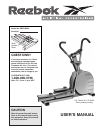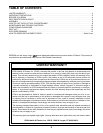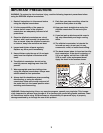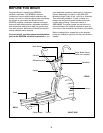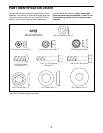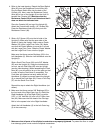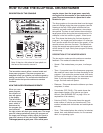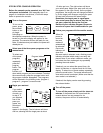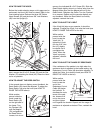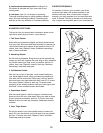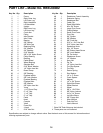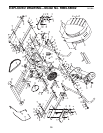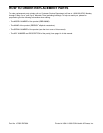
12
CONDITIONING GUIDELINES
The following guidelines will help you to plan your
exercise program. Remember that proper nutrition and
adequate rest are essential for successful results.
WARNING: Before beginning this or any exercise
program, consult your physician. This is especial-
ly important for individuals over the age of 35 or
individuals with pre-existing health problems.
WHY EXERCISE?
Exercise has proven essential for good health and
well-being. Participation in a well-rounded exercise
program helps to develop a stronger and more effi-
cient heart, improved respiratory function, increased
stamina, better weight management, increased ability
to handle stress, and greater self-esteem.
EXERCISE INTENSITY
Whether your goal is to burn fat or to strengthen your
cardiovascular system, the key to achieving the
desired results is to exercise with the proper intensity.
The proper intensity level can be found by using your
heart rate as a guide. For effective exercise, your heart
rate should be maintained at a level between 70% and
85% of your maximum heart rate as you exercise. This
is known as your training zone. You can find your train-
ing zone in the table below. Training zones are listed
according to age and physical condition.
Burning Fat
To burn fat effectively, you must exercise at the proper
intensity level for a sustained period of time. During
the first few minutes of exercise, your body uses easi-
ly accessible carbohydrate calories for energy. Only
after the first few minutes does your body begin to use
stored fat calories for energy. If your goal is to burn
fat, keep your heart rate in the lower half of your train-
ing zone as you exercise.
Aerobic Exercise
If your goal is to strengthen your cardiovascular sys-
tem, your exercise must be Òaerobic.Ó Aerobic exercise
is activity that requires large amounts of oxygen for
prolonged periods of time. This increases the demand
on the heart to pump blood to the muscles, and on the
lungs to oxygenate the blood. For effective aerobic
exercise, keep your heart rate in the higher half of
your training zone as you exercise. Note: During the
first few weeks of your exercise program, it is recom-
mended that you keep your heart rate in the lower half
of the your training zone as you exercise.
HOW TO MEASURE YOUR HEART RATE
To measure
your heart rate,
stop exercising
and place two
fingers on your
wrist as shown.
Take a six-sec-
ond heartbeat
count, and mul-
tiply the result
by ten to find
your heart rate. (A six-second count is used because
your heart rate drops quickly when you stop exercis-
ing.) If your heart rate is too high, decrease the inten-
sity of your exercise. If your heart rate is too low,
increase the intensity of your exercise.
WORKOUT GUIDELINES
A proper workout includes the following three parts:
A warm-up, consisting of 5 to 10 minutes of stretching
and light exercise. A proper warm-up increases the
body temperature, heart rate, and circulation in prepa-
ration for exercise.
TRAINING ZONE (BEATS/MIN.)
20
25
30
35
40
45
50
55
60
65
70
75
80
85
AGE CONDITIONEDUNCONDITIONED
133Ð162
132Ð160
130Ð158
129Ð156
127Ð155
125Ð153
124Ð150
122Ð149
121Ð147
119Ð145
118Ð144
117Ð142
115Ð140
114Ð139
138Ð167
136Ð166
135Ð164
134Ð162
132Ð161
131Ð159
129Ð156
127Ð155
126Ð153
125Ð151
123Ð150
122Ð147
120Ð146
118Ð144



